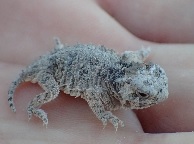Description: The Texas horned lizard is the largest-bodied and most widely distributed of the roughly -1 species of horned lizards in the western United States and Mexico. The Texas horned lizard exhibits sexual dimorphism, with the females being larger with a snout-vent length of around 5 inches, whereas the males reach around 3.7 inches.Phrynosoma cornutum has characteristic horns spanning across its body with the two largest crowning its head, two more on its brows and jawline respectively, as well as lines of spikes spanning the lateral parts of torso and dorsal ridges of the back. Coloration varies depending on the environment in order to blend in with the color of the ground, ranging from a yellow or reddish-brown for deserts to a tannish brown for prairies. They also have dark lines that span from the eyes to the tip of the horns and a characteristic solid white line with a few black circular splotches on either side.
Habitat: Texas horned lizards reside in arid or semi-arid regions with access to open ground and some scattered vegetative cover. These areas include a number of early successional habitats like prairies, dunes, and deserts. They also include the edge habitat of playas, which are flat desert basins that are normally dry, but may become shallow lakes after rainfall. These areas also include bajadas, which are slopes of fertile soil found along the foot of a mountain. Texas horned lizards have been reported at elevations from 106 m to 1,330 m above sea level.
Range: The Texas horned lizard, like all members of the genus Phrynosoma, is endemic to North America where it occurs in south-central regions of the US and northeastern Mexico. Its natural distribution includes southeast Colorado, central and southern areas of Kansas, central and western areas of Oklahoma and Texas, southeast New Mexico, and extreme southeast Arizona.
Reproduction: The breeding season for Texas horned lizards begins immediately after hibernation from mid-April and continues until mid-June. Males travel more during the first month after hibernation in search of receptive females than during all other times of the year.
To express interest in a female, male Texas horned lizards will perform their species-specific display of quickly bobbing their heads up and down. Females may reject males by simply moving away or by waving their tails. The lizards experience a type of amplexus for a couple hours, where the male is atop the female.
The mating system of the Texas horned lizard is unknown; however, females will reject all other attempts at courtship after mating. After mating ceases, the male also shows no further interest in the female.
The breeding season of Texas horned lizards begins immediately after hibernation in mid-April and continues until mid-June. Females will have only a single clutch per year. There are no records of how many times males may reproduce during a single breeding season.
Females deposit their eggs 44 days after copulation in a burrow, where the eggs will incubate for 40 to 61 days. Around 14 to 37 eggs have been reported in a single clutch, with the larger clutches laid by older, larger females. Females do not stay with the clutch.
The gestation period is typically 44 days, and incubation times are 40-61 days. Time to independence is immediately upon hatching, as parents do not protect the nest or the young. Both males and females reach sexual maturity two years after hatching.
Approximately 44 days after copulation, female Texas horned lizards dig a tunnel to deposit their eggs. They dig with their forelimbs, pushing excess soil out of the entrance with their hind limbs, often stopping to look around their environment. The tunnels reach from 12 to 25 centimeters deep, sloping 25 to 60 degrees downward.
After laying their eggs, females refill the tunnel using their forelimbs and head, then scatter the soil around to hide evidence of their nesting site. The whole nesting process may take an individual 5 to 10 hours to complete.
Females stay near the nesting site for a few hours after finishing their work, then leave the eggs. No further parental involvement occurs. Hatchlings are independent immediately after hatching.
Status: Listed as Least Concern because the extent of occurrence, area of occupancy, number of subpopulations, and population size remain relatively large, despite declines in some (mostly marginal) portions of the range.








